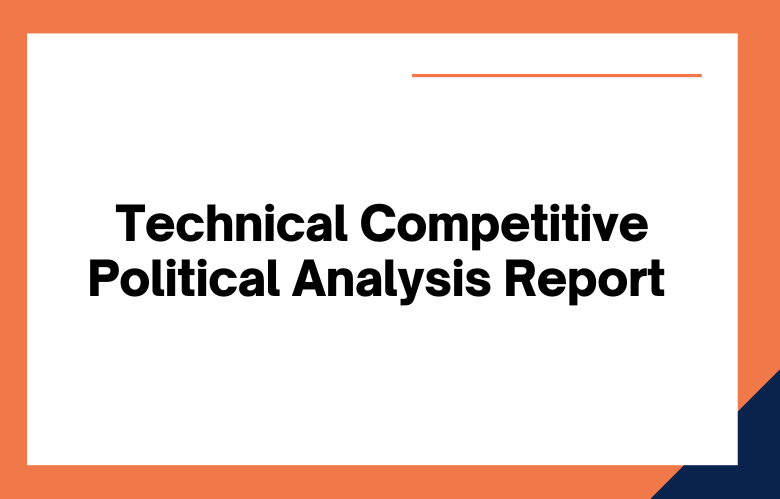Political campaigns and organizations must conduct technical competitive political analysis reports to stay ahead. Such reports provide a comprehensive view of the current political landscape, helping decision-makers better understand their opponents’ positions and strategies.
A technical competitive political analysis report should include metrics such as opinion polling data, demographic information, voting trends, and advertising strategies.
This type of report can provide invaluable insight into the tactics and strategies used by competing candidates or organizations.
Let’s explore some benefits of conducting technical competitive political analysis reports in more detail.
Technical Competitive Political Analysis Report Metrics
What are Metrics?
Metrics are measurements that capture data to understand various aspects of an issue or topic. These measurements, such as polls, surveys, or voting results, can be qualitative or quantitative.
They are used to identify trends and patterns in data that can provide insight into a region’s politics. It helps analysts identify what type of policies would benefit their constituents the most.
In competitive political analysis, metrics are primarily used to evaluate performance and compare different areas within a country or region.
For example, an analyst could use metric analysis to compare voting trends across different states and determine which form is more likely to support specific policy initiatives.
This information can then inform decision-making when crafting legislation or implementing new policies.
Using Metrics Effectively
For metric analysis to be practical, it must be accurate and timely. Collecting data from reliable sources and double-checking it for accuracy before using it in your research is essential.
If you want your analysis to be functional, you must update your metrics regularly to reflect current trends in the area you are assessing.
If your metrics become outdated quickly, they will not provide meaningful insight into a region’s or country’s political conditions.
The Benefits of Conducting Technical Competitive Political Analysis Reports
Opinion Polling Data
An opinion polling data metric lets you dive deep into public sentiment on specific issues or candidates. By understanding how people feel about particular topics or candidates, you can craft messages that resonate with voters and hone your campaign’s outreach strategy accordingly.
Analyzing opinion polling data can help you identify voter trends in specific regions or demographic groups so that you can tailor your messaging to appeal to them.
Demographic Information
Demographic information provides an overview of the population that you are targeting with your campaign or organization’s efforts. It includes age ranges, gender breakdowns, educational attainment levels, income brackets, religious affiliations, and other relevant characteristics.
By understanding your target audience, you can craft messages tailored specifically for those who will grab their attention and keep them interested in your cause or candidate.
This type of report can help you identify potential areas for expansion if necessary.
Voting Trends
Voting trends allow decision-makers to understand better how different groups have voted in previous elections and anticipate what they may do in future ones.
This type of information provides a window into the minds of voters across geographic regions or demographic groups so that campaigns can craft messages designed to appeal directly to them while avoiding efforts that may prove counterproductive.
Knowing how specific populations have voted in past elections also allows campaigns and organizations to anticipate potential shifts in voting behavior when crafting their strategies for upcoming contests.
Advertising Strategies
A technical competitive political analysis report should also include metrics related to advertising strategies utilized by competing campaigns or organizations and other external entities attempting to influence public opinion on particular issues or candidates.
This type of information can provide invaluable insight into effective techniques opponents use, which may apply to your efforts. It can also help decision-makers identify potential weaknesses that could be exploited by their rivals and any external entities attempting to sway public opinion against them.
How to Utilize Technical Competitive Political Analysis Report Metrics
A technical competitive political analysis report can be an invaluable resource if you’re looking to understand the dynamics and nuances of a particular political race.
These reports provide detailed insights into the election landscape, offering valuable information about the candidates’ strengths and weaknesses and how they compare. Let’s look at how to use this data to gain deeper insight into any race.
Competitive Assessment
The competitive assessment section is the first thing you should look at when utilizing this report. This section provides an in-depth look at the current state of the race by analyzing both qualitative and quantitative metrics.
It examines polling data, voter sentiment, fundraising numbers, media coverage, and more. It will give you a holistic view of each candidate’s performance to better understand who is likely to win.
Analyzing Fundraising Numbers
Fundraising numbers are another critical metric to consider when analyzing a political race.
The amount of money each candidate has raised can tell you a lot about their level of support within the community and their ability to spread their message.
You can also use these numbers to predict whether or not they have enough resources to mount an effective campaign against their opponent.
Evaluating Media Coverage
Media coverage is another crucial metric you should consider when conducting your analysis. Media coverage can offer insight into which issues are frequently discussed about the election and what topics resonate with voters most strongly.
It can also provide insight into which candidates have been able to effectively communicate their messages to voters through interviews and other public appearances.
Voting Power Index (VPI)
The VPI is used to compare the voting power of one candidate against another. This metric measures the number of votes each candidate has received and compares them against each other.
It can also track changes in voting patterns over time and see where potential shifts might occur. This metric helps measure voter engagement and enthusiasm for specific candidates or issues.
Approval Rating
The approval rating measures how much support a particular candidate has from their constituents or followers.
This metric considers positive and negative feedback and provides an overall view of people’s feelings about a specific individual or issue.
It can gauge public opinion on various topics and determine which candidates will most likely win an election.
Fundraising Rate
The fundraising rate is a crucial metric in any political analysis report because it indicates how much money each candidate has been able to raise during their campaign period.
It considers all sources of funds, including donations from individuals, businesses, groups, foundations, etc., and other sources such as grants and loans from outside organizations or governments.
This metric can provide valuable insight into which candidates have successfully raised funds for their campaigns and who may have had difficulty doing so.
Conclusion
Understanding public sentiment and voter behavior through technical competitive political analysis reports is essential for any successful campaign or organization seeking success at the ballot box or within its industry sector.
Comprehensive metrics such as opinion polling data, demographic information, voting trends, and advertising strategies provide invaluable insight into how best to craft compelling messages tailored toward specific audiences while avoiding potentially counterproductive tactics from competitors inside and outside one’s industry sector.
By utilizing these types of reports effectively, decision-makers can better understand their rivals’ positions while also identifying new opportunities for growth along the way.
Navigating the ever-changing technical and political landscape can be both complex and daunting.
Whether you are an incumbent trying to stay in power or a challenger hoping to gain a foothold, the metrics from our Technical Competitive Political Analysis Report can help provide you with the valuable insight needed to craft campaigns that expertly target your intended audience.
With elections on the horizon, time is of the essence; for a comprehensive report detailing precise trends, demographics, and long-term strategies for victory, contact us today about our customized Competitive Political Analysis Consulting services.
It is time to make your voice heard. Please take advantage of our expertise and ensure your policies reach their full potential!
Technical competitive political analysis report metrics provide invaluable insights when determining new strategies and approaches for various vital issues.
The data and analyses highlighted in this post demonstrate the importance of thorough research and industry expertise in determining one’s best position. Without these tools, companies risk significant consequences, such as resource losses, market standing, reputational damage, etc.
To ensure that your organization takes full advantage of potential political opportunities, consider hiring specialists in competitive political analysis consulting with the knowledge and resources necessary to equip you for success.
Call: +91 9848321284
Email: [email protected]
Political Analysis Report Metrics: FAQs
What is a technical political analysis report?
It’s a structured evaluation of political data, trends, and digital signals that help campaigns assess their performance against competitors in real time or over a defined period.
Why is competitive political analysis important?
It reveals what your opponents are doing, where they’re gaining traction, and how your own campaign stacks up—so you can adjust strategy accordingly.
What are the key components of a competitive political report?
These typically include social media metrics, website analytics, ad spending patterns, search visibility, voter sentiment, messaging trends, and demographic reach.
How often should a political analysis report be updated?
Weekly or biweekly updates are ideal during active campaign periods, especially when online sentiment or competitor activity shifts quickly.
What digital metrics matter most in these reports?
Engagement rate, ad performance (CPM, CTR), follower growth, hashtag trends, website traffic sources, and bounce rates are commonly tracked.
How do these reports track opponent campaigns?
By monitoring public-facing data like social media posts, ad libraries, influencer collaborations, mentions in the press, and audience interaction metrics.
Can these reports analyze sentiment and emotion?
Yes. Sentiment analysis tools assess the tone of public conversation to see if voters view a candidate positively, negatively, or neutrally.
What platforms are typically monitored?
Facebook, Instagram, Twitter/X, YouTube, Google Search, TikTok, WhatsApp broadcasts, and major news outlets are all included for tracking.
How is ad spend tracked in a competitor report?
Tools like Meta Ad Library or Google Ads Transparency Center help estimate competitor ad volume, formats, placements, and themes.
What’s the role of SEO metrics in political analysis?
SEO data shows how well a campaign ranks for key issues, candidate names, or local terms that voters search for—an important piece of digital visibility.
Do these reports include voter targeting insights?
Yes. They examine how campaigns segment audiences and tailor messaging across different voter demographics or interest groups.
How do heatmaps contribute to political analysis?
Heatmaps visualize engagement or attention across geographic regions, highlighting strongholds, swing areas, or digital gaps.
What tools are used for building these reports?
Google Analytics, Semrush, Ahrefs, Sprout Social, Hootsuite, Brandwatch, CrowdTangle, and ad library scrapers are often used together.
Can a technical political report reveal misinformation trends?
Yes. It can flag coordinated misinformation campaigns, fake accounts, or viral narratives that could affect voter behavior.
How are KPIs set in political reporting?
They’re based on campaign goals—like follower growth, volunteer signups, fundraising conversions, or voter contact reach.
Do these reports help with debate or media prep?
Absolutely. They offer insights into what the public is reacting to, what your opponent is pushing, and which issues are trending.
Can this analysis track issue-based engagement?
Yes. You can monitor how voters respond to different policy messages like healthcare, jobs, or education across platforms.
How does competitor benchmarking work in these reports?
Your campaign’s digital and field metrics are compared against those of opponents to measure effectiveness and gaps.
Is it possible to automate competitive tracking?
Yes. Dashboards and alert systems can track changes in real time, including ad launches, major posts, or shifts in sentiment.
What’s the biggest mistake campaigns make with these reports?
They collect data but fail to act on it. Insights must lead to strategy changes, not just sit in a PDF.











